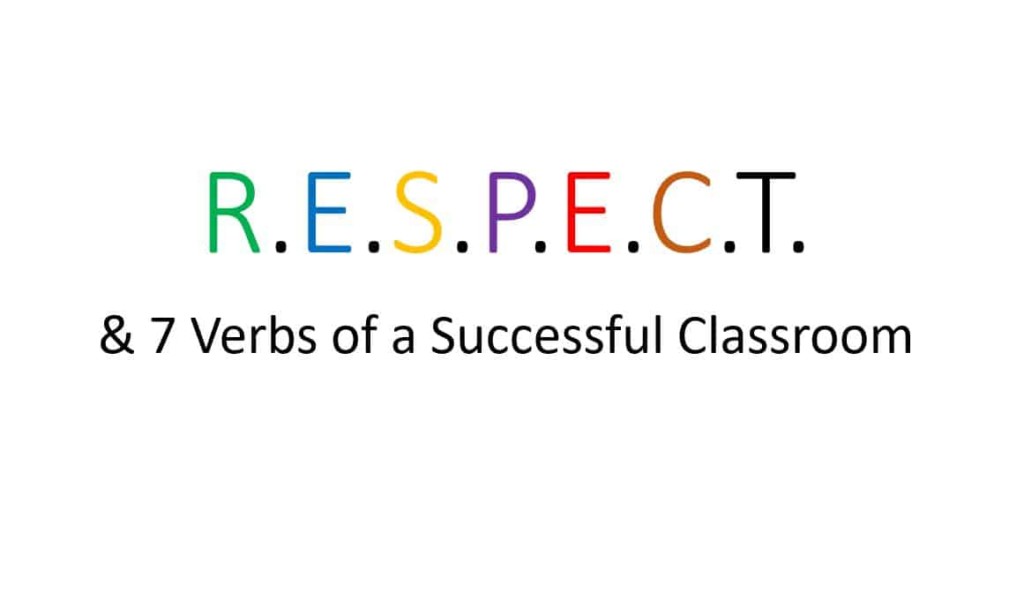Creating Positive Learning Environments for a New School Year

I am a firm believer that respect and disrespect can both be felt.
No. Scratch that. I don’t believe. I know. Whether verbal or nonverbal, intentional or unintentional, respect and its ugly counterpart give off distinct vibes. Those benign or malignant vibes send out far-reaching waves that affect all in their paths.
This truth is especially evident in today’s classrooms. After twenty years in a high school English Language Arts classroom, I have learned that nothing is more crucial than creating a positive learning environment where respect and all of its verbal disciples are as ubiquitous and reliable as oxygen.
So, before I and other educators (blessed with such important jobs) embark on another amazing school year, let’s review R.E.S.P.E.C.T. and seven verbs of a successful classroom.
For starters, here is how respect looks…and feels.
Remember
In my humble opinion, some educators have forgotten how difficult life can be as a kid or a teenager. I’ve forgotten before. More than ever, today’s teachers must remember how challenging it was as youngsters to deal with bullying, social norms, peer pressure, awkward and rapidly changing bodies, acne, anxiety, uncertainty about the future, uninspiring classrooms, excessive homework that edges out family and play time, keeping up with current clothing trends and fads, and adults’ expectations.
Growing up was certainly challenging for me, and I didn’t even have a powerful gadget in my hand 24/7 that connected me to the world and all my “friends” via social media. I wasn’t concerned with being “liked,” “friended” or “snapped” in a digital world. I was only concerned with being “liked” and “friended” in-person by those I aspired to have as buddies. And if my feelings of friendship went unrequited, I often felt as if I might “snap.” There’s no telling what obstacles and temptations we all may have faced if we had to navigate through adolescence in today’s fast-paced world.
And who knows what goes on when some students return home? As Nicholas A. Ferroni says, “Students who are loved at home come to school to learn, and students who aren’t come to school to be loved.”
Yep, it is safe to say that we must remember our own successes and struggles as students, so we will never underestimate, overlook or waste our students’ potential.
Sometimes a student like the one below is simply covered up by the same baggage we once discarded. How we felt during those times must be remembered.
Listen. I may not know much, but I know one thing: I don’t want to compete with Google, YouTube, smartphones, Chromebooks and other educational technology. Instead, I want to leverage these tools to maximize students’ success.
Lest our memories suffer and we look like a pompous donkey’s butt. Much like this “educator.”
Energize
Please allow one of my former students to summarize this powerful aspect of R.E.S.P.E.C.T.
“I mean how in the world can teachers expect us to get excited in class when teachers act like they don’t even want to be at school? Some teachers even say, ‘All right. I know y’all don’t want to do this, but we have to ’cause those are the standards and that’s how we all get graded. By the test scores.’ Then, some of the teachers plop down behind their desks and throw bookwork our way. It’s simple, Mr. Hardison. We get jacked about learning when the teacher gets pumped, too. You know, when the teacher wants to be here.” – Lauren
I’m not sure I’ll ever be a high school principal or assistant principal, but if I do, I will certainly have my antennae up during interviews for two powerful characteristics of an effective teacher: a good heart and energy.
Here’s an example of how it looks when a passionate teacher, with a good heart, energizes the learning atmosphere.
Showcase
In the past, showcasing students’ exemplary work may have included local newspapers, classroom chalkboards, hallway bulletin boards, gold stars on students’ papers and monthly PTO meetings. Today, YouTube, Wix and Weebly, WordPress and Blogger, Instagram, Twitter, Snapchat and many other digital tools provide a platform that showcases students’ very best to the entire world.
It really is hard to imagine today’s teachers not participating in at least one of these digital mediums.
In fact, it is high time we meet students where they are, not where we were.
And when we do, we will have classes rockin’ like this by showcasing students’ unique talents:
Participate
One rule I try to always adhere to is this: Be willing to participate in whatever I ask my students to do. This often equates to performing a T-Rex during lunchtime, singing the blues with a talented colleague, writing and rapping (or trying to rap) in front of a recording microphone, communicating on a live backchannel, or even improvising on stage to bring literature to life. Simply put: I don’t ask what I won’t do.
However, the students’ participation is much more important than mine. The trick, I have learned, is to inspire and encourage participation, not demand and force it.
Take a look at this master teacher in-action:
Expect
When I think back to my greatest and most successful teachers and coaches, they all expected my very best. They understood it would possibly take a while, but they never wavered in the belief that I had much more to give and achieve. I am forever grateful to them for their persistence and for the bar they raised so high. In many ways, they raised the bar so high that I am still stretching upwards, and I can still hear their inspirational words.
They sounded something like this:
Create
Ahhh. Now this one is my favorite. All of my career I have worked relentlessly to make creativity the foundation of our classroom.
Sure, I teach to the standards. Absolutely. Every single day. However, I am fully aware that covering such riveting material as passive voice and fused sentences (information that can be Googled in a matter of seconds) is unlikely to induce former students to run over to me years later in a grocery store and reminisce about life-changing grammar lessons. However, I cannot count the number of times students have approached me in public to relive the moments we created parodies, original songs, mini-movies, concerts, talk shows, 90-second summaries, slow jams, and fiery debates through interactive learning structures and Skype sessions.
Again. All standards-based and with a purpose. Just with a very creative slant and a little more time needed.
But students’ creativity is well worth the wait and oftentimes surprising. Much like this:
A classroom that inspires students to speak as honestly as this one:
Triumph
Whenever I am fortunate enough to sit at length and collaborate with my esteemed colleagues, the same topic rises to the forefront, and I am privileged to hear story after story about students who knocked down obstacles and whipped challenges on their way to success. Students who triumphed.
At this time, I am always inspired by these indomitable spirits.
Triumph like this:
I don’t know about you, but I’ll always be studying them.
After all, I’m just a student.
Aren’t all teachers?
For more, see:
- Is 100% Student Engagement Possible? You Bet It Is.
- 40 “Teaching Madness” Indicators For Educators
- Bad Breath and the Art of Teaching
Stay in-the-know with all things EdTech and innovations in learning by signing up to receive the weekly Smart Update.



Mark
Good ideas overall. Respect is my one and only classroom rule - respect yourself, other students, and the teacher. I like the emphasis in the acronyms about engagement and creative lessons. However, I am concerned when blog posts like this disparage knowledge and the value of an expert ("boring" and "arrogant"). Knowledge is important, and just because a student can google answers doesn't mean they can contextualize and connect without an expert teacher. I utilize lecture/direct instruction but any decent teacher will interweave that with questioning, opportunities to discuss or reflect, movement, and so forth. Without lecture or direct instruction, classes can become a series of hands-on tech projects that don't connect or paint a larger narrative.
Corbin
Great article, John. Thank you! Great movie clips too. Morgan Freeman has pulled his weight in teaching about RESPECT ....
Meeting students where they are and truly seeing each student, implied in the "Remember" element, is critical before other meaningful progress can be made. Unfortunately, it's given little attention and effort and therefore rarely achieved. I would vote for "Relationship" to be considered as a potential replacement for the R of RESPECT. It turns the focus to now and the future with all possible situations, instead of the fixed past too.
kate Miller
Respect is the only thing I ask of my students, also. When there is respect, the sky is the limit to what can be achieved.